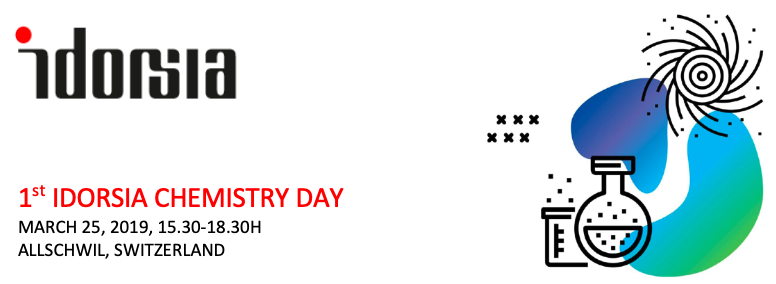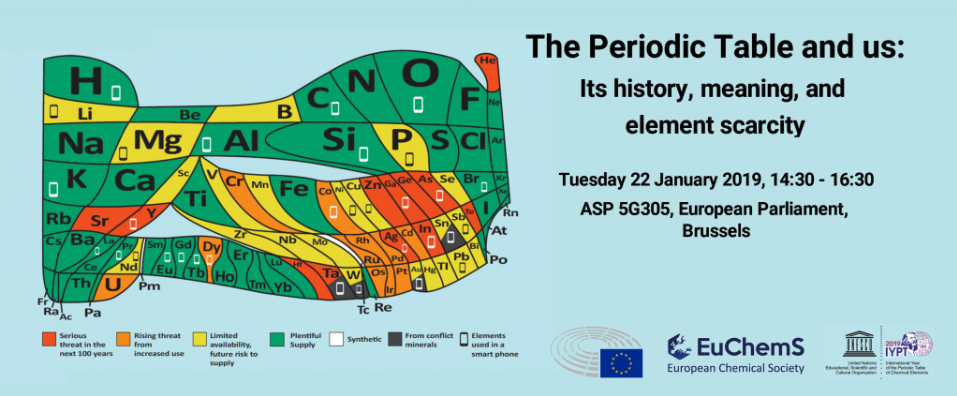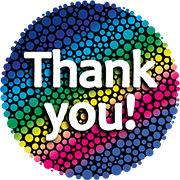1st Idorsia Chemistry Day, 25 March 2019

The R&D Department of Idorsia invites you to the 1st Idorsia Chemistry Day 2019 that will take place in Allschwil on March 25, 2019.
Program
Chair: Dr. Gabriel Schäfer, Scientist Chemistry Process R&D
| 15.30 | Welcome by Dr. Stefan Abele, Head Chemical Development |
| 15.40 | Dr. Martin Eastgate, Bristol-Myers Squibb «Innovation in the Synthesis of Complex Pharmaceuticals» |
| 16.40 | Prof. Richmond Sarpong, University of California, Berkeley «Break it to Make it Strategies for Complex Molecule Synthesis» |
| 17.40 | Closing remarks by Dr. Thomas Weller, Head of Drug Discovery, Chemistry |
| 17.45 | Aperitif |
Location
Idorsia Pharmaceuticals Ltd
Hegenheimermattweg 91 4123 Allschwil, Switzerland
www.idorsia.com
Registration
Attendance will be limited to 100 participants.
Registration is free of charge. Please register until March 15, 2019, by sending a mail to Dr. Gabriel Schäfer ().
David Spichiger, SCS
15.01.2019
The Periodic Table and us: its history, meaning, and element scarcity, 22 Jan 2019, Brussels

Join us on Tuesday 22 January 2019, from 14:30 – 16:30 in the European Parliament in Brussels, Room ASP 5G305 for the launching of the EuChemS Periodic Table depicting element scarcity, and to listen to a series of talks on the history of the periodic table, its meaning, and what lies ahead in the future. The event is chaired by Member of the European Parliament Catherine Stihler.
Indeed, the phone you may be using right now to read this is made up of some 30 elements – over half of which may give cause for concern in the years to come because of increasing scarcity. With some 10 million smartphones being discarded or replaced every month in the European Union alone, serious actions to tackle the challenges ahead are needed. Element scarcity is intrinsically linked with discussions on the Circular Economy, more efficient recycling practices, innovative alternatives, consumer behaviour, and more besides. Unless solutions are provided, we risk seeing many of the natural elements that make up the world around us run out or become unusable – whether because of limited supplies, their location in conflict areas, or our incapacity to fully recycle them.
Please find below the preliminary programme & registration for the event.
Registration deadline: 15 January 2019
Programme, registration and list of speakers on the website of EuChemS
David Spichiger, SCS
28.12.2018
ChemPubSoc Europe Newsletter, December 2018
![]()
ChemPubSoc Europe was proud to support your publishing endeavors in 2018. As the calendar year ticks over, we reflect and bring you a selection of highlights. In a special item, we reveal the secret life of new journals as told by our resident expert. ChemPubSoc Europe's journals look forward to celebrating the International Year of the Periodic Table of Chemical Elements (IYPT2019), but before we go we want to say: "Thank you!"
Memorable moments of 2018
 In a year of unforgettable experiences, which memories stand out for you? In 2018, our editors were among you, at workshops, campus events, conferences, receptions and meetings all over the world. We've relished the opportunity to support you, your articles, research group, institute, and society. This item brings you a selection of recent activities at ChemPubSoc Europe journals and ChemViews Magazine.
In a year of unforgettable experiences, which memories stand out for you? In 2018, our editors were among you, at workshops, campus events, conferences, receptions and meetings all over the world. We've relished the opportunity to support you, your articles, research group, institute, and society. This item brings you a selection of recent activities at ChemPubSoc Europe journals and ChemViews Magazine.
Picture credit: S. Sasse-Rösch, red moon over Weinheim, home of the publishing house located between Frankfurt and Heidelberg, 2018.
The secret life of new journals
 In an interview with editor Greta Heydenrych we explore new journals. Why and how they are created, what challenges they face in a modern publishing environment, and who they are intended to serve. With the leadership and support of excellent chairpersons, board members, and a diligent team of editors, ChemPubSoc Europe has welcomed three new journals to its portfolio since 2016: ChemPhotoChem, Batteries & Supercaps, and the newest addition ChemSystemsChem.
In an interview with editor Greta Heydenrych we explore new journals. Why and how they are created, what challenges they face in a modern publishing environment, and who they are intended to serve. With the leadership and support of excellent chairpersons, board members, and a diligent team of editors, ChemPubSoc Europe has welcomed three new journals to its portfolio since 2016: ChemPhotoChem, Batteries & Supercaps, and the newest addition ChemSystemsChem.
We're all in it together: partners in chemistry
 Sincere thanks from all of us at the publishing house!We look forward to working with you and for you in 2019, which will be a year full of initiatives to promote you and your exciting research. Join ChemPubSoc Europe for the IYPT2019,* ChemCatChem's 10th Anniversary, a celebration of women in STEM, and much more. Further information is available in the 2019 Editorials published in Issue 1 of each journal, which are free to read.
Sincere thanks from all of us at the publishing house!We look forward to working with you and for you in 2019, which will be a year full of initiatives to promote you and your exciting research. Join ChemPubSoc Europe for the IYPT2019,* ChemCatChem's 10th Anniversary, a celebration of women in STEM, and much more. Further information is available in the 2019 Editorials published in Issue 1 of each journal, which are free to read.
*Enter the Element Video Competition for the chance to win an iPad.
ChemPubSoc Europe's publishing program has grown to 15 chemistry journals and an international scientific magazine. We await your high-quality contributions with enthusiasm!
Visit ChemPubSoc Europe online and on Twitter. For regular updates subscribe to the ChemPubSoc Europe newsletter and the monthly newsletter published by the award-winning team at ChemViews Magazine. Contact ChemPubSoc Europe with your society news.
David Spichiger, SCS
27.12.2018
EuCheMS Brussels News Updates, December 2018

Horizon Europe - continued
Negotiations surrounding the future EU research framework programme Horizon Europe are progressing although diverging conclusions are slowly being reached between the European Parliament and the Council. In addition, national ministers themselves are split on a number of central issues. At heart of the different viewpoints for Horizon Europe is that of whether to continue maintaining the notion of ‘excellence’ as the central pillar, or whether to shape Horizon Europe as a tool to help fix the research and innovation divide between western and eastern Member States. Read more about the latest progress on Horizon Europe here.
Plan S: China, petitions, events & a GDCh statement
Plan S, the plan initiated by a coalition of European funders (cOAlition S) and supported by the European Commission to encourage a rapid transition to open access publishing continues to make waves within the scientific community. From petitions, China's unexpected interest in Plan S, events in Brussels, a GDCh statement and a public consultation, we've provided you with a quick overview of the latest developments and debates. Click here for the full debrief.
Report of the 2nd Employment Survey for European Chemists is published
The report of the 2nd Employment Survey for European Chemists (ESEC2) was published on 21 November. The report, which analysed data received in 2017, delves into the employment conditions and career opportunities for chemists in Europe. Read more about the report here.
Forums and events - EuChemS attends EFSA Stakeholder Forum, European Parliament Impact Research EU event & ECHA Committee for Risk Assessment meeting
Last month saw the annual European Food Safety Agency (EFSA) Stakeholder Forum, an event which sought to stimulate and simplify dialogue between the European Agency and official stakeholders. The event also aimed to exchange views on EFSA’s ongoing work and plans for the future. The relatively new and bolstered role of academic organisations was recognised by EFSA as a positive and much needed aspect of stakeholder interaction. Full debrief of the meeting here.
EuChemS also attended the high-level conference on how research and innovation affect daily life which was held in the European Parliament. The event, which combined talks with representatives from the European Commission, European Parliament and ministers from EU Member States as well as a range of scientists, explored the major challenges we currently face, and how impact research can and should continue to be fostered in Europe. Read all about it here.
EuChemS attended the European Chemical Agency’s Committee for Risk Assessment (RAC) – 47 meeting in Helsinki in November. The RAC prepares the opinions of ECHA related to the risks of substances to human health and the environment, although final decisions are taken by the European Commission. Click here for more information.
Open Access: Plan S guidelines
A public consultation has now been opened on the Plan S guidelines. EuChemS is currently preparing a Position Paper on the topic.
Deadline: 1st February 2019
Read the full BNU newsletter here
David Spichiger, SCS
27.12.2018
Open Position @UZH: Assistant Professor Tenure Track in Next Generation Synthesis

The Faculty of Science at the University of Zurich invites applications for an
Assistant Professor Tenure Track in Next Generation Synthesis
We are seeking for candidates with an outstanding track record to build an internationally recognized research program in organic synthesis. While all areas of organic chemistry will be considered, upon equal qualifications, preference will be given to applicants with an interest in technology-driven synthesis, new molecular concepts, molecular systems engineering, «on-demand» synthesis, or new molecular frameworks. The selected candidate is expected to lead an independent research group and to participate in teaching chemistry at all levels of the BSc, MSc and PhD programs. The University of Zurich has an established program for career progression allowing promotion to associate and full professor upon successful evaluation.
The University of Zurich provides generous research support, including dedicated funds for personnel, running expenses and competitive start-up packages. Moreover, the successful applicant is expected to acquire external research funding. Zurich’s scientific environment encompasses a rich spectrum of diverse activities spanning physical to biomedical research that provides extensive opportunities for collaboration with research groups at the University of Zurich and other leading Swiss research institutions.
The employment conditions for this position follow the legal regulations of the University of Zurich (see www.prof.uzh.ch/de.html), which include part-time options. The University of Zurich is an equal opportunities employer and in particular strives to increase the percentage of women in leading positions (see https://www.mnf.uzh.ch/en/mnf-gleichstellung.html). Therefore, qualified female researchers are particularly encouraged to apply. The city of Zurich combines a stimulating cultural scene in a modern European city with easy access to a beautiful natural landscape.
Academics with the appropriate qualifications are kindly invited to submit their applications including:
- a curriculum vitae
- lists of publications and research funding,
- a detailed research plan and a teaching outline
- names and contact details of three referees
Please address your application to Prof. Roland Sigel, Dean of the Faculty of Science.
Upload your application files to http://www.mnf.uzh.ch/ngs by 22 Feburary 2019.
For further information, please contact Prof. Dr. Karl Gademann (email: ).
David Spichiger, SCS
27.12.2018
Page 76 of 304
